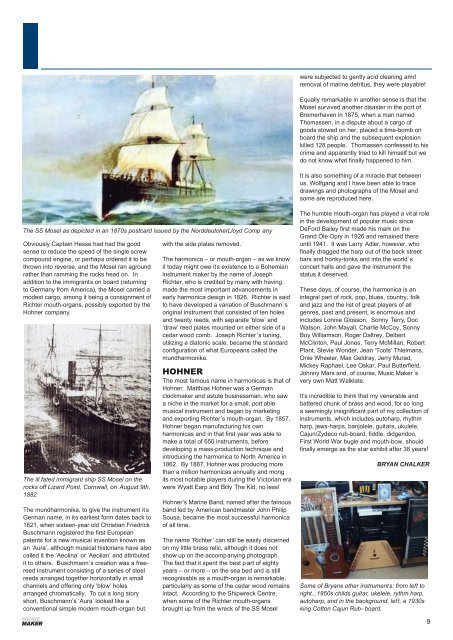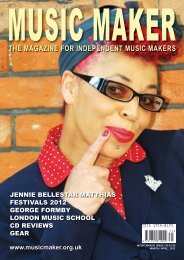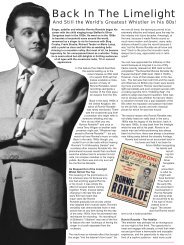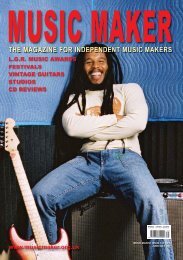the magazine for independent music makers - The Music Maker Guide
the magazine for independent music makers - The Music Maker Guide
the magazine for independent music makers - The Music Maker Guide
You also want an ePaper? Increase the reach of your titles
YUMPU automatically turns print PDFs into web optimized ePapers that Google loves.
<strong>The</strong> SS Mosel as depicted in an 1870s postcard issued by <strong>the</strong> NorddeutcherLloyd Comp any<br />
Obviously Captain Hesse had had <strong>the</strong> good<br />
sense to reduce <strong>the</strong> speed of <strong>the</strong> single screw<br />
compound engine, or perhaps ordered it to be<br />
thrown into reverse, and <strong>the</strong> Mosel ran aground<br />
ra<strong>the</strong>r than ramming <strong>the</strong> rocks head on. In<br />
addition to <strong>the</strong> immigrants on board (returning<br />
to Germany from America), <strong>the</strong> Mosel carried a<br />
modest cargo, among it being a consignment of<br />
Richter mouth-organs, possibly exported by <strong>the</strong><br />
Hohner company.<br />
<strong>The</strong> ill fated immigrant ship SS Mosel on <strong>the</strong><br />
rocks off Lizard Point, Cornwall, on August 9th,<br />
1882<br />
<strong>The</strong> mundharmonika, to give <strong>the</strong> instrument it s<br />
German name, in its earliest <strong>for</strong>m dates back to<br />
1821, when sixteen-year old Christian Friedrick<br />
Buschmann registered <strong>the</strong> first European<br />
patents <strong>for</strong> a new <strong>music</strong>al invention known as<br />
an ‘Aura’, although <strong>music</strong>al historians have also<br />
called it <strong>the</strong> ‘Aeolina’ or ‘Aeolian’ and attributed<br />
it to o<strong>the</strong>rs. Buschmann’s creation was a freereed<br />
instrument consisting of a series of steel<br />
reeds arranged toge<strong>the</strong>r horizontally in small<br />
channels and offering only ‘blow’ holes<br />
arranged chromatically. To cut a long story<br />
short, Buschmann’s ‘Aura’ looked like a<br />
conventional simple modern mouth-organ but<br />
MUSIC<br />
MAKER<br />
with <strong>the</strong> side plates removed.<br />
<strong>The</strong> harmonica – or mouth-organ – as we know<br />
it today might owe its existence to a Bohemian<br />
instrument maker by <strong>the</strong> name of Joseph<br />
Richter, who is credited by many with having<br />
made <strong>the</strong> most important advancements in<br />
early harmonica design in 1826. Richter is said<br />
to have developed a variation of Buschmann’ s<br />
original instrument that consisted of ten holes<br />
and twenty reeds, with separate ‘blow’ and<br />
‘draw’ reed plates mounted on ei<strong>the</strong>r side of a<br />
cedar wood comb. Joseph Richter ’s tuning,<br />
utilizing a diatonic scale, became <strong>the</strong> st andard<br />
configuration of what Europeans called <strong>the</strong><br />
mundharmonika.<br />
HOHNER<br />
<strong>The</strong> most famous name in harmonicas is that of<br />
Hohner. Matthias Hohner was a German<br />
clockmaker and astute businessman, who saw<br />
a niche in <strong>the</strong> market <strong>for</strong> a small, port able<br />
<strong>music</strong>al instrument and began by marketing<br />
and exporting Richter’s mouth-organ. By 1857,<br />
Hohner began manufacturing his own<br />
harmonicas and in that first year was able to<br />
make a total of 650 instruments, be<strong>for</strong>e<br />
developing a mass-production technique and<br />
introducing <strong>the</strong> harmonica to North America in<br />
1862. By 1887, Hohner was producing more<br />
than a million harmonicas annually and mong<br />
its most notable players during <strong>the</strong> Victorian era<br />
were Wyatt Earp and Billy <strong>The</strong> Kid, no less!<br />
Hohner’s Marine Band, named after <strong>the</strong> famous<br />
band led by American bandmaster John Philip<br />
Sousa, became <strong>the</strong> most successful harmonica<br />
of all time.<br />
<strong>The</strong> name ‘Richter’ can still be easily discerned<br />
on my little brass relic, although it does not<br />
show up on <strong>the</strong> accompanying photograph.<br />
<strong>The</strong> fact that it spent <strong>the</strong> best p art of eighty<br />
years – or more – on <strong>the</strong> sea bed and is still<br />
recognisable as a mouth-organ is remarkable,<br />
particularly as some of <strong>the</strong> cedar wood remains<br />
intact. According to <strong>the</strong> Shipwreck Centre,<br />
when some of <strong>the</strong> Richter mouth-organs<br />
brought up from <strong>the</strong> wreck of <strong>the</strong> SS Mosel<br />
were subjected to gently acid cleaning amd<br />
removal of marine detritus, <strong>the</strong>y were playable!<br />
Equally remarkable in ano<strong>the</strong>r sense is that <strong>the</strong><br />
Mosel survived ano<strong>the</strong>r disaster in <strong>the</strong> port of<br />
Bremerhaven in 1875, when a man named<br />
Thomassen, in a dispute about a cargo of<br />
goods stowed on her, placed a time-bomb on<br />
board <strong>the</strong> ship and <strong>the</strong> subsequent explosion<br />
killed 128 people. Thomassen confessed to his<br />
crime and apparently tried to kill himself but we<br />
do not know what finally happened to him.<br />
It is also something of a miracle that between<br />
us, Wolfgang and I have been able to trace<br />
drawings and photographs of <strong>the</strong> Mosel and<br />
some are reproduced here.<br />
<strong>The</strong> humble mouth-organ has played a vit al role<br />
in <strong>the</strong> development of popular <strong>music</strong> since<br />
DeFord Bailey first made his mark on <strong>the</strong><br />
Grand Ole Opry in 1926 and remained <strong>the</strong>re<br />
until 1941. It was Larry Adler, however, who<br />
finally dragged <strong>the</strong> harp out of <strong>the</strong> back street<br />
bars and honky-tonks and into <strong>the</strong> world’ s<br />
concert halls and gave <strong>the</strong> instrument <strong>the</strong><br />
status it deserved.<br />
<strong>The</strong>se days, of course, <strong>the</strong> harmonica is an<br />
integral part of rock, pop, blues, country, folk<br />
and jazz and <strong>the</strong> list of great players of all<br />
genres, past and present, is enormous and<br />
includes Lonnie Glosson, Sonny Terry, Doc<br />
Watson, John Mayall, Charlie McCoy, Sonny<br />
Boy Williamson, Roger Daltrey, Delbert<br />
McClinton, Paul Jones, Terry McMillan, Robert<br />
Plant, Stevie Wonder, Jean ‘Toots’ Thielmans,<br />
Onie Wheeler, Max Geldray, Jerry Murad,<br />
Mickey Raphael, Lee Oskar, Paul Butterfield,<br />
Johnny Mars and, of course, <strong>Music</strong> <strong>Maker</strong> ’s<br />
very own Matt Walklate.<br />
It’s incredible to think that my venerable and<br />
battered chunk of brass and wood, <strong>for</strong> so long<br />
a seemingly insignificant part of my collection of<br />
instruments, which includes autoharp, rhythm<br />
harp, jews-harps, banjolele, guitars, ukulele,<br />
Cajun/Zydeco rub-board, fiddle, didgeridoo,<br />
First World War bugle and mouth-bow, should<br />
finally emerge as <strong>the</strong> star exhibit after 38 years!<br />
BRYAN CHALKER<br />
Some of Bryans o<strong>the</strong>r instruments: from left to<br />
right...1950s childs guitar, ukelele, rythm harp,<br />
autoharp, and in <strong>the</strong> background, left, a 1930s<br />
king Cotton Cajun Rub- board.<br />
9





